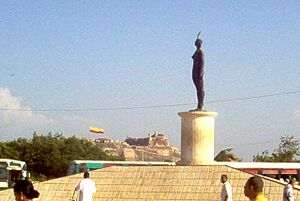India Catalina facts for kids
Quick facts for kids
Catalina
|
|
|---|---|
| Born | c. 1495 |
| Died | May 11 1538, Cartagena de Indias. |
| Occupation | Translator, interpreter |
| Known for | Translator for Pedro de Heredia during the Spanish conquest of the Chibchan Nations. |
| Spouse(s) | Alonso Montañez |
India Catalina (born around 1495 – died May 11, 1538) was an indigenous girl from the Mokaná people. She lived on the Atlantic coast of what is now Colombia. Catalina became a very important interpreter and helper for Pedro de Heredia. She played a key role during the Spanish conquest of Colombia.
Contents
Catalina's Early Life and Role
Catalina was the daughter of a local chief. In 1509, a Spanish explorer named Diego de Nicuesa brought her from her home. This was an indigenous village called Zamba o Galerazamba in the Bolívar region.
She was taken to Santo Domingo, a Spanish settlement. There, she learned the Spanish language and became a Catholic Christian. Even though she learned Spanish ways, she was not a free person.
Catalina as an Interpreter
Catalina became a vital interpreter for Pedro de Heredia. He was a Spanish leader during the conquest of Colombia. She helped him talk to the Native Americans. Her ability to speak both Spanish and indigenous languages was very important. It helped the Spanish communicate and understand the local people.
The name "India Catalina" means "the Indian Catalina." This name appeared in a letter sent by Pedro de Heredia to King Carlos V in 1533. Her original indigenous name was not written down in these old documents. However, a Colombian TV show called "La reina de Indias y el conquistador" suggests her indigenous names were Katalydeyewua and Kaitegua.
Later Life and Death
Catalina later married Alonso Montañez, who was Pedro de Heredia's nephew. She lived in Cartagena de Indias until her death. India Catalina passed away on May 11, 1538.
Monument to India Catalina
A famous monument honors India Catalina. It was created by the sculptor Eladio Gil Zambrana. The statue was shown to the public in 1974.
Small copies of this monument are given as awards. They are used at the Cartagena Film Festival. This shows how important India Catalina is to Colombian history and culture.
See also
 In Spanish: India Catalina para niños
In Spanish: India Catalina para niños


